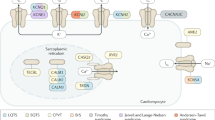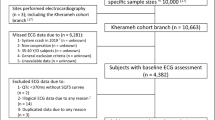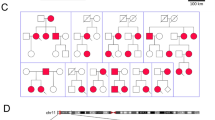Abstract
Short QT syndrome is an inheritable primary electrical disease of the heart that was discovered in 1999. The disorder is characterized by an abnormally short QT interval (<300 ms) and a propensity to atrial fibrillation, sudden cardiac death or both. As in the case of long QT syndrome, more than one relevant genetic mutation has been identified that can lead to a short QT interval on electrocardiography; so far two have been identified. Shortening of the effective refractory period combined with increased dispersion of repolarization is the likely substrate for re-entry and life-threatening tachyarrhythmias. Thus far, 22 people have been classified as having short QT syndrome: 15 from the actual measurement of a short QT interval on electrocardiograms and 7 by history after they died from sudden cardiac death. Several cases, especially among children, have probably been overlooked, since the shortness of the QT interval becomes apparent only at heart rates less than 80 beats/min. The best form of treatment is still unknown, but prevention of atrial fibrillation has been accomplished by propafenone. Implantation of an implantable cardioverter defibrillator is recommended for prevention of sudden cardiac death.
This is a preview of subscription content, access via your institution
Access options
Subscribe to this journal
Receive 12 print issues and online access
$209.00 per year
only $17.42 per issue
Buy this article
- Purchase on Springer Link
- Instant access to full article PDF
Prices may be subject to local taxes which are calculated during checkout


Similar content being viewed by others
References
Ackerman MJ (1998) The long QT syndrome: ion channel diseases of the heart. Mayo Clin Proc 73: 250–269
Nierenberg DW and Ransil BJ (1979) Q-aTc Interval as a clinical indicator of hypercalcemia. Am J Cardiol 44: 243–248
Gussak I et al. (2000) Idiopathic short QT interval: a new clinical syndrome? Cardiology 94: 99–102
Gaita F et al. (2003) Short QT Syndrome. A Familial Cause of Sudden Death. Circulation 108: 965–970
Brugada R et al. (2004) Sudden Death Associated With Short-QT Syndrome Linked to Mutations in HERG. Circulation 109: 30–35
Bellocq C et al. (2004) Mutation in the KCNQ1 Gene Leading to the Short QT-Interval Syndrome. Circulation 109: 2394–2397
Rautaharju PM et al. (1992) Sex differences in the evolution of the electrocardiographic QT interval with age. Can J Cardiol 8: 690–695
Bjerregaard P and Gussak I (2004) Atrial Fibrillation in the Setting of Familial Short QT Syndrome [abstract]. Heart Rhythm 1: S165
Schimpf R et al. (2003) Congenital Short QT Syndrome and Implantable Cardioverter Defibrillator Treatment: Inherent Risk for Inappropriate Shock Delivery. J Cardiovasc Electrophysiol 14: 1273–1277
Gaita F et al. (2004) Short QT Syndrome: Pharmacological Treatment. J Am Coll Cardiol 43: 1494–1499
Author information
Authors and Affiliations
Corresponding author
Ethics declarations
Competing interests
The authors declare no competing financial interests.
Rights and permissions
About this article
Cite this article
Bjerregaard, P., Gussak, I. Short QT syndrome: mechanisms, diagnosis and treatment. Nat Rev Cardiol 2, 84–87 (2005). https://doi.org/10.1038/ncpcardio0097
Received:
Accepted:
Issue Date:
DOI: https://doi.org/10.1038/ncpcardio0097
This article is cited by
-
Computational prediction of the effect of D172N KCNJ2 mutation on ventricular pumping during sinus rhythm and reentry
Medical & Biological Engineering & Computing (2020)
-
Pro-arrhythmogenic Effects of the V141M KCNQ1 Mutation in Short QT Syndrome and Its Potential Therapeutic Targets: Insights from Modeling
Journal of Medical and Biological Engineering (2017)
-
Mechanisms of sudden cardiac death
Journal of Nuclear Cardiology (2016)
-
Potassium-channel mutations and cardiac arrhythmias—diagnosis and therapy
Nature Reviews Cardiology (2012)
-
Channelopathies: Brugada syndrome, long QT syndrome, short QT syndrome, and CPVT
Herz (2009)



